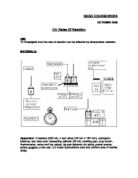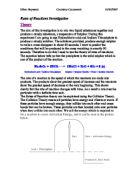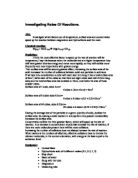4. Place the beakers (B and C) containing the test tubes on an electrical hot plate, switch on the power and place a thermometer into each of the four test tubes.
5. Read each thermometer until the water in beaker B reaches 37ºC and the water in beaker C reaches 100ºC (i.e. when the water boils). At these points, remove the beakers from the hot plate and switch off the power.
6. Wait a few minutes and check the thermometers until the test tube temperatures are constant, and similar to the temperature of the water bath.
7. Add 0.25 g of weighed marble chips to beaker B (37ºC), and time the period of reaction between the marble chips and the hydrochloric acid with a stopwatch. When all the marble chips have fully dissolved and the reaction ceased, stop the stopwatch and note down the time taken for the reaction.
8. Write down these results into the results table and repeat this process for beaker C (at 100ºC) and beaker A (at room temperature - approximately 20ºC).
9. Finally with beaker D, place a thermometer in this beaker to provide a temperature check and then add 150 ml of crushed ice to act as a constant temperature ice bath. Again, wait a few minutes and check the thermometers until the test tube temperatures are constant and similar to the temperature of the ice in the beaker (I.e. 0ºC). Add 0.25g of weighed marble chips. Then finally use the stopwatch to time how long it takes for the marble chips to dissolve in the hydrochloric acid and write down the results.
10. Clean up used materials and wash hands thoroughly.
VARIABLES:
Independent Variables: Temperature.
Dependent Variables: The reaction time.
CONTROLS:
The standard 10 ml volume of 3.0 molar hydrochloric acid in each test tube, the mass, uniform size and surface area of the five marble chips placed into each acid, constant temperature measurement using a thermometer for each beaker and test tube (I.e. A: 20ºC, B: 37ºC, C: 100ºC and D: 0ºC) and time observation using a stopwatch to measure the duration of reaction time of acid on the marble chips.
RESULTS:
This table clearly shows that the higher the temperature, the faster the reaction rate. In these experiments, I used five marble chips for each test tube to ensure consistency and therefore production of carbon dioxide.
Five weighed marble chips = 0.25g
CONCLUSION:
This experiment showed that the higher the temperature, the faster the reaction rate and thereby, the faster the production of carbon dioxide from hydrochloric acid acting on marble chips.
EVALUATION:
My results table above successfully proved that the temperature had a large effect on the rates of reaction and showed that the higher the temperature, the faster the rate of reaction.
The rates of chemical reaction increases with temperature, This is because when the temperature is increased, the particles in the solution have more energy and therefore collide more often during a certain period of time. These colliding particles will have activation energy resulting in more successful collisions between particles, the cause of reaction. As shown on my graph, the rate of reaction approximately doubles each time the temperature is increased by 10ºC.
With regard to sources of error, some time was taken to press the stopwatch when the marble chips had thoroughly dissolved. This would have altered the length of reaction time a little bit and therefore alter the rate of reaction results. At first, I weighed one marble chip and multiplied it by 5 to get the mass of five marble chips. As this would have made my results inaccurate, I weighed the five marble chips all together to get the exact mass of 0.25g.







